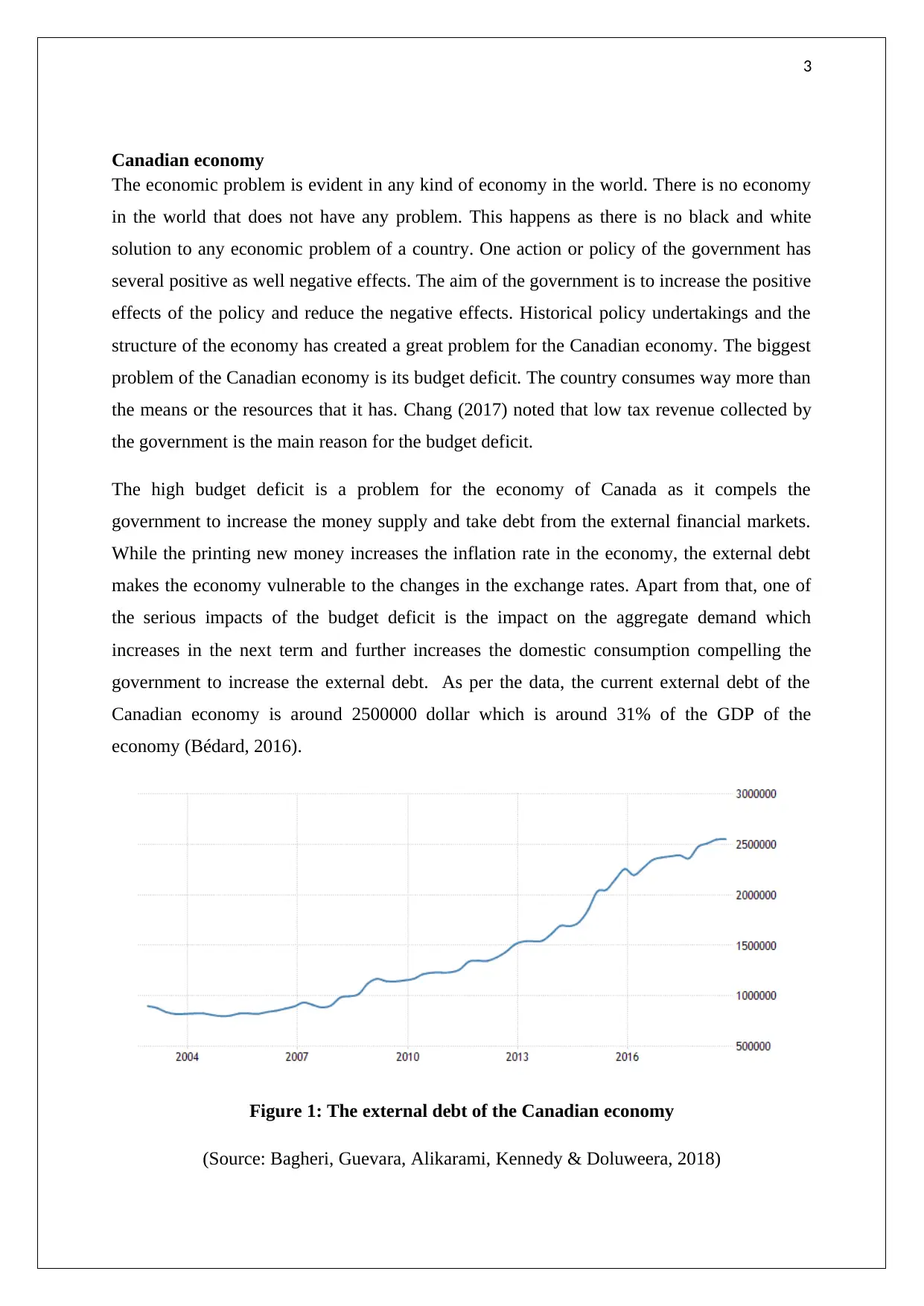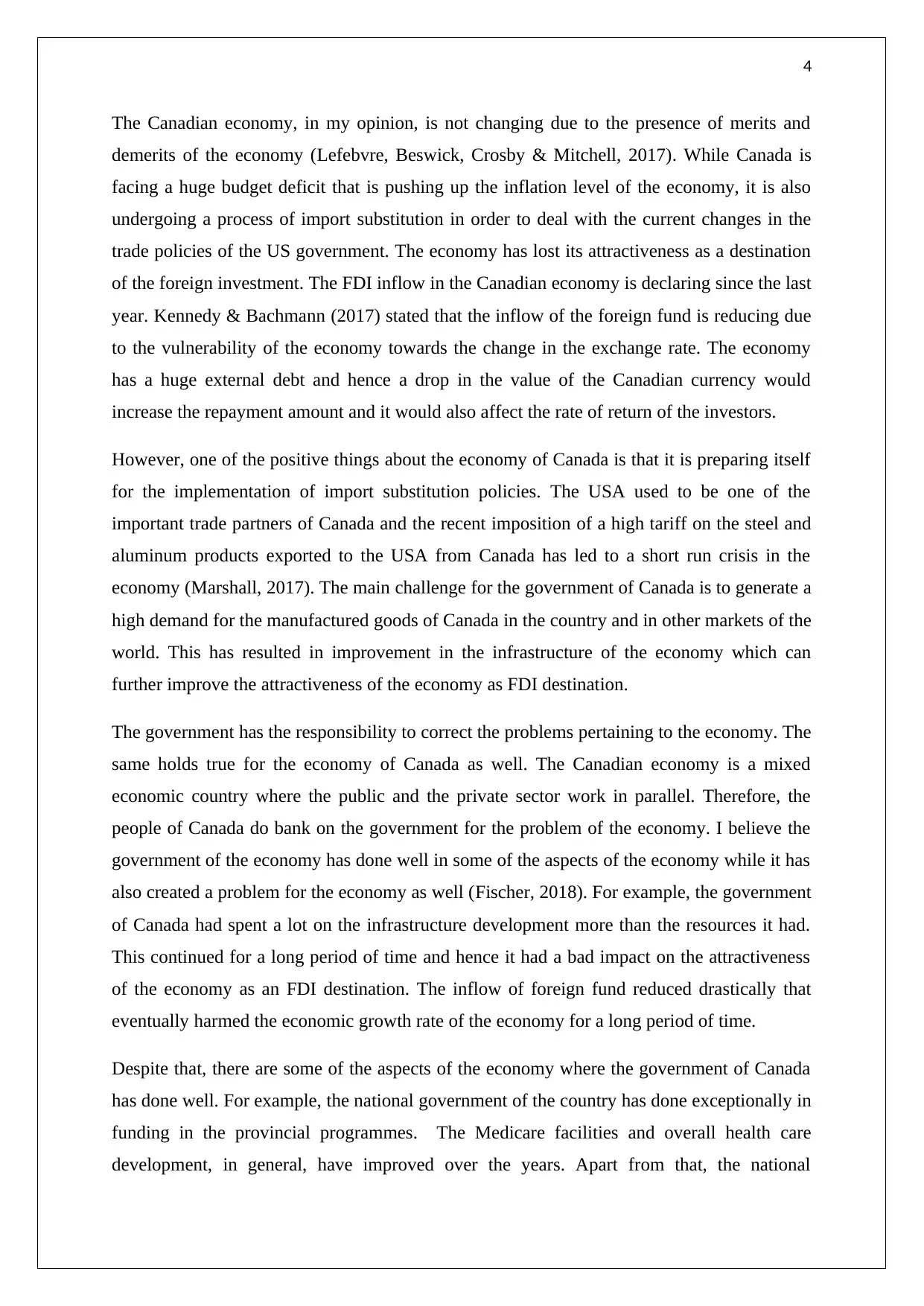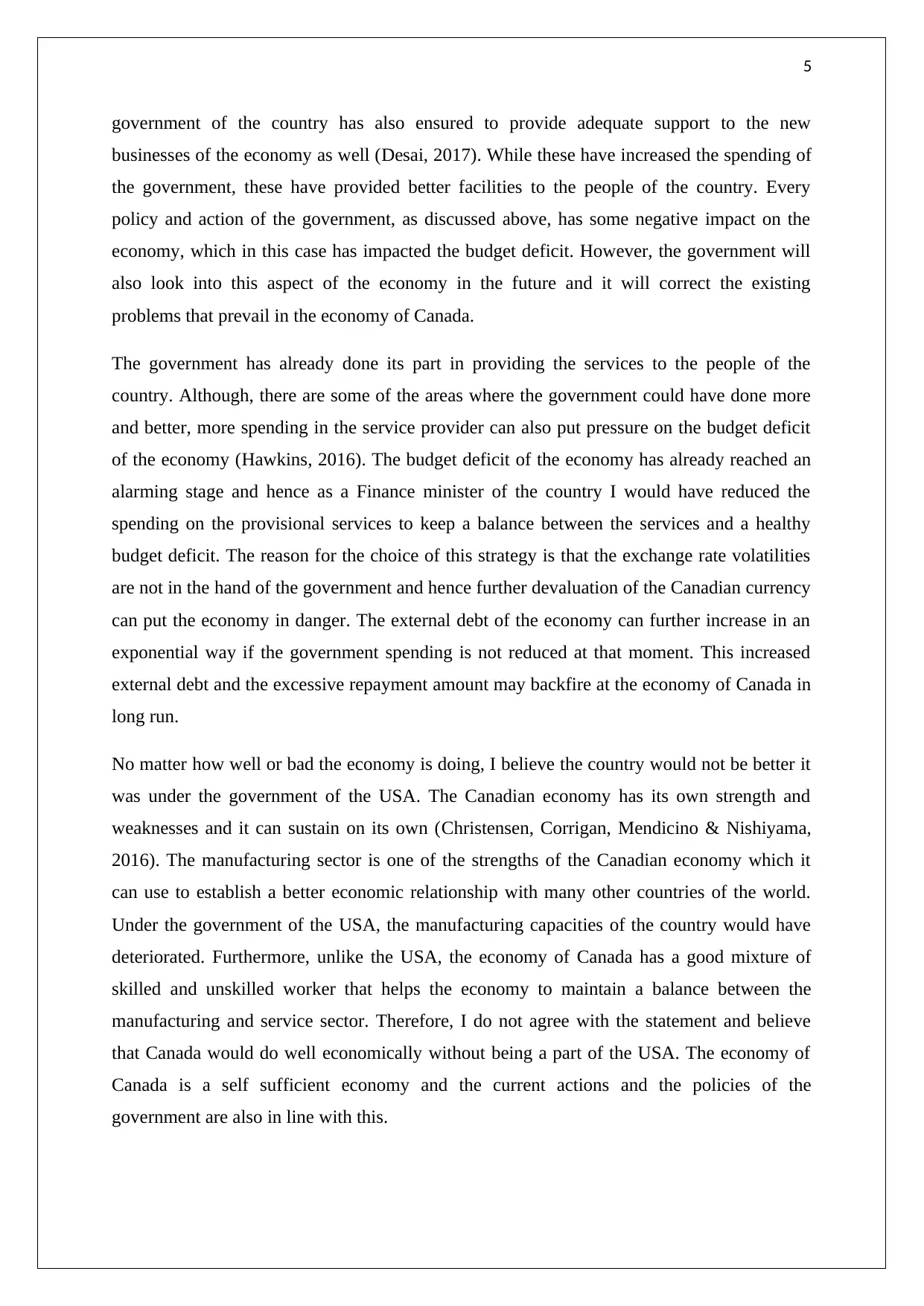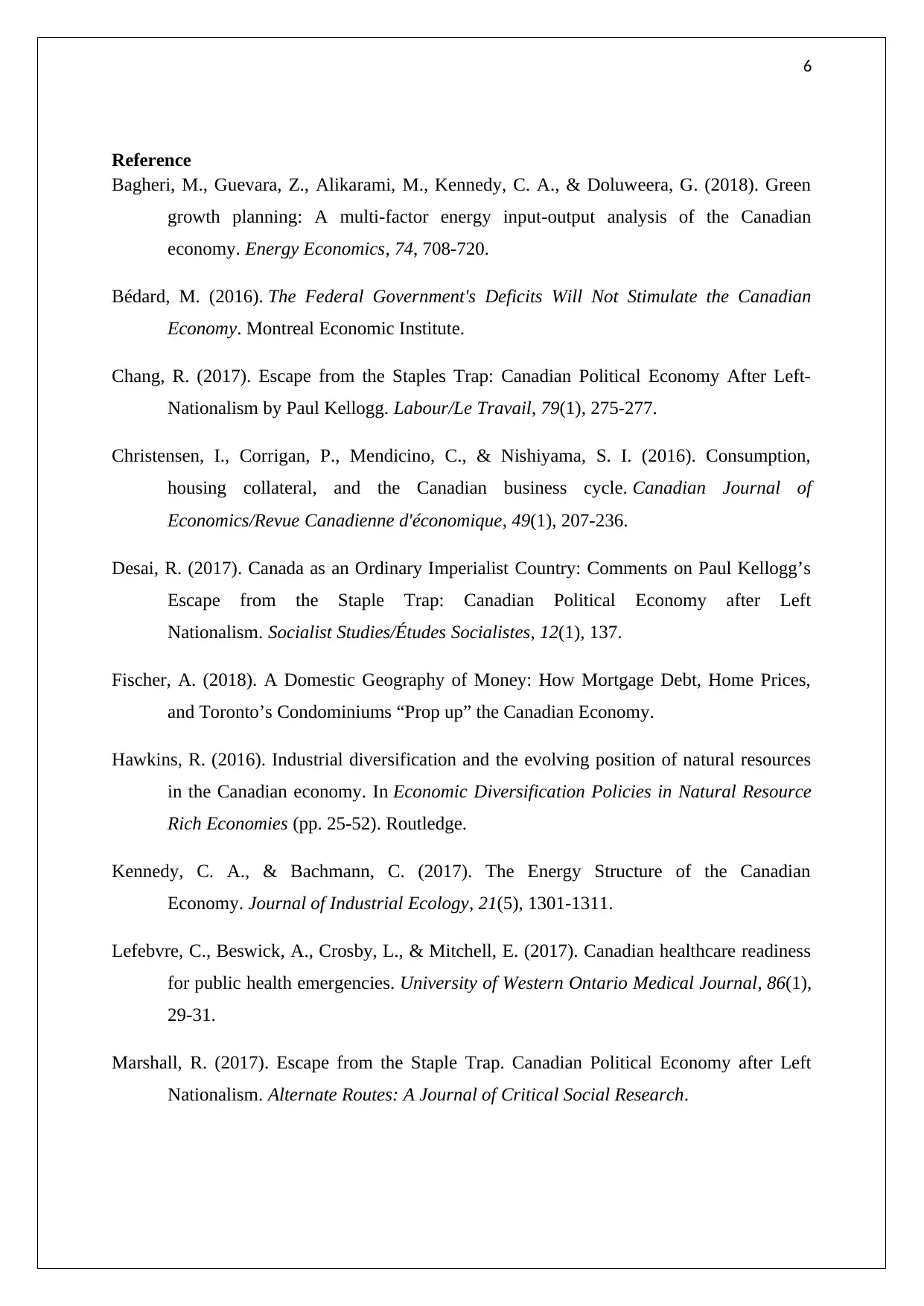Economic Analysis of Canada: Budget Deficit and Policy Impacts
VerifiedAdded on 2023/04/22
|6
|1716
|404
Report
AI Summary
This economics report provides an analysis of the Canadian economy, focusing on its key challenges and policy responses. The primary issue discussed is the persistent budget deficit, attributed to low tax revenue and its implications, including increased external debt and vulnerability to exchange rate fluctuations. The report explores the government's response, including import substitution policies in light of changing trade relations with the USA. It also examines the government's role in infrastructure development, healthcare, and support for new businesses. The author, assuming the role of a Finance Minister, suggests reducing spending on provincial services to manage the budget deficit. The report concludes with a perspective on Canada's economic self-sufficiency and its strengths in the manufacturing sector.

1
ECONOMICS ASSIGNMENT
ECONOMICS ASSIGNMENT
Paraphrase This Document
Need a fresh take? Get an instant paraphrase of this document with our AI Paraphraser

2
Contents
Canadian economy.....................................................................................................................3
Reference....................................................................................................................................6
Contents
Canadian economy.....................................................................................................................3
Reference....................................................................................................................................6

3
Canadian economy
The economic problem is evident in any kind of economy in the world. There is no economy
in the world that does not have any problem. This happens as there is no black and white
solution to any economic problem of a country. One action or policy of the government has
several positive as well negative effects. The aim of the government is to increase the positive
effects of the policy and reduce the negative effects. Historical policy undertakings and the
structure of the economy has created a great problem for the Canadian economy. The biggest
problem of the Canadian economy is its budget deficit. The country consumes way more than
the means or the resources that it has. Chang (2017) noted that low tax revenue collected by
the government is the main reason for the budget deficit.
The high budget deficit is a problem for the economy of Canada as it compels the
government to increase the money supply and take debt from the external financial markets.
While the printing new money increases the inflation rate in the economy, the external debt
makes the economy vulnerable to the changes in the exchange rates. Apart from that, one of
the serious impacts of the budget deficit is the impact on the aggregate demand which
increases in the next term and further increases the domestic consumption compelling the
government to increase the external debt. As per the data, the current external debt of the
Canadian economy is around 2500000 dollar which is around 31% of the GDP of the
economy (Bédard, 2016).
Figure 1: The external debt of the Canadian economy
(Source: Bagheri, Guevara, Alikarami, Kennedy & Doluweera, 2018)
Canadian economy
The economic problem is evident in any kind of economy in the world. There is no economy
in the world that does not have any problem. This happens as there is no black and white
solution to any economic problem of a country. One action or policy of the government has
several positive as well negative effects. The aim of the government is to increase the positive
effects of the policy and reduce the negative effects. Historical policy undertakings and the
structure of the economy has created a great problem for the Canadian economy. The biggest
problem of the Canadian economy is its budget deficit. The country consumes way more than
the means or the resources that it has. Chang (2017) noted that low tax revenue collected by
the government is the main reason for the budget deficit.
The high budget deficit is a problem for the economy of Canada as it compels the
government to increase the money supply and take debt from the external financial markets.
While the printing new money increases the inflation rate in the economy, the external debt
makes the economy vulnerable to the changes in the exchange rates. Apart from that, one of
the serious impacts of the budget deficit is the impact on the aggregate demand which
increases in the next term and further increases the domestic consumption compelling the
government to increase the external debt. As per the data, the current external debt of the
Canadian economy is around 2500000 dollar which is around 31% of the GDP of the
economy (Bédard, 2016).
Figure 1: The external debt of the Canadian economy
(Source: Bagheri, Guevara, Alikarami, Kennedy & Doluweera, 2018)
⊘ This is a preview!⊘
Do you want full access?
Subscribe today to unlock all pages.

Trusted by 1+ million students worldwide

4
The Canadian economy, in my opinion, is not changing due to the presence of merits and
demerits of the economy (Lefebvre, Beswick, Crosby & Mitchell, 2017). While Canada is
facing a huge budget deficit that is pushing up the inflation level of the economy, it is also
undergoing a process of import substitution in order to deal with the current changes in the
trade policies of the US government. The economy has lost its attractiveness as a destination
of the foreign investment. The FDI inflow in the Canadian economy is declaring since the last
year. Kennedy & Bachmann (2017) stated that the inflow of the foreign fund is reducing due
to the vulnerability of the economy towards the change in the exchange rate. The economy
has a huge external debt and hence a drop in the value of the Canadian currency would
increase the repayment amount and it would also affect the rate of return of the investors.
However, one of the positive things about the economy of Canada is that it is preparing itself
for the implementation of import substitution policies. The USA used to be one of the
important trade partners of Canada and the recent imposition of a high tariff on the steel and
aluminum products exported to the USA from Canada has led to a short run crisis in the
economy (Marshall, 2017). The main challenge for the government of Canada is to generate a
high demand for the manufactured goods of Canada in the country and in other markets of the
world. This has resulted in improvement in the infrastructure of the economy which can
further improve the attractiveness of the economy as FDI destination.
The government has the responsibility to correct the problems pertaining to the economy. The
same holds true for the economy of Canada as well. The Canadian economy is a mixed
economic country where the public and the private sector work in parallel. Therefore, the
people of Canada do bank on the government for the problem of the economy. I believe the
government of the economy has done well in some of the aspects of the economy while it has
also created a problem for the economy as well (Fischer, 2018). For example, the government
of Canada had spent a lot on the infrastructure development more than the resources it had.
This continued for a long period of time and hence it had a bad impact on the attractiveness
of the economy as an FDI destination. The inflow of foreign fund reduced drastically that
eventually harmed the economic growth rate of the economy for a long period of time.
Despite that, there are some of the aspects of the economy where the government of Canada
has done well. For example, the national government of the country has done exceptionally in
funding in the provincial programmes. The Medicare facilities and overall health care
development, in general, have improved over the years. Apart from that, the national
The Canadian economy, in my opinion, is not changing due to the presence of merits and
demerits of the economy (Lefebvre, Beswick, Crosby & Mitchell, 2017). While Canada is
facing a huge budget deficit that is pushing up the inflation level of the economy, it is also
undergoing a process of import substitution in order to deal with the current changes in the
trade policies of the US government. The economy has lost its attractiveness as a destination
of the foreign investment. The FDI inflow in the Canadian economy is declaring since the last
year. Kennedy & Bachmann (2017) stated that the inflow of the foreign fund is reducing due
to the vulnerability of the economy towards the change in the exchange rate. The economy
has a huge external debt and hence a drop in the value of the Canadian currency would
increase the repayment amount and it would also affect the rate of return of the investors.
However, one of the positive things about the economy of Canada is that it is preparing itself
for the implementation of import substitution policies. The USA used to be one of the
important trade partners of Canada and the recent imposition of a high tariff on the steel and
aluminum products exported to the USA from Canada has led to a short run crisis in the
economy (Marshall, 2017). The main challenge for the government of Canada is to generate a
high demand for the manufactured goods of Canada in the country and in other markets of the
world. This has resulted in improvement in the infrastructure of the economy which can
further improve the attractiveness of the economy as FDI destination.
The government has the responsibility to correct the problems pertaining to the economy. The
same holds true for the economy of Canada as well. The Canadian economy is a mixed
economic country where the public and the private sector work in parallel. Therefore, the
people of Canada do bank on the government for the problem of the economy. I believe the
government of the economy has done well in some of the aspects of the economy while it has
also created a problem for the economy as well (Fischer, 2018). For example, the government
of Canada had spent a lot on the infrastructure development more than the resources it had.
This continued for a long period of time and hence it had a bad impact on the attractiveness
of the economy as an FDI destination. The inflow of foreign fund reduced drastically that
eventually harmed the economic growth rate of the economy for a long period of time.
Despite that, there are some of the aspects of the economy where the government of Canada
has done well. For example, the national government of the country has done exceptionally in
funding in the provincial programmes. The Medicare facilities and overall health care
development, in general, have improved over the years. Apart from that, the national
Paraphrase This Document
Need a fresh take? Get an instant paraphrase of this document with our AI Paraphraser

5
government of the country has also ensured to provide adequate support to the new
businesses of the economy as well (Desai, 2017). While these have increased the spending of
the government, these have provided better facilities to the people of the country. Every
policy and action of the government, as discussed above, has some negative impact on the
economy, which in this case has impacted the budget deficit. However, the government will
also look into this aspect of the economy in the future and it will correct the existing
problems that prevail in the economy of Canada.
The government has already done its part in providing the services to the people of the
country. Although, there are some of the areas where the government could have done more
and better, more spending in the service provider can also put pressure on the budget deficit
of the economy (Hawkins, 2016). The budget deficit of the economy has already reached an
alarming stage and hence as a Finance minister of the country I would have reduced the
spending on the provisional services to keep a balance between the services and a healthy
budget deficit. The reason for the choice of this strategy is that the exchange rate volatilities
are not in the hand of the government and hence further devaluation of the Canadian currency
can put the economy in danger. The external debt of the economy can further increase in an
exponential way if the government spending is not reduced at that moment. This increased
external debt and the excessive repayment amount may backfire at the economy of Canada in
long run.
No matter how well or bad the economy is doing, I believe the country would not be better it
was under the government of the USA. The Canadian economy has its own strength and
weaknesses and it can sustain on its own (Christensen, Corrigan, Mendicino & Nishiyama,
2016). The manufacturing sector is one of the strengths of the Canadian economy which it
can use to establish a better economic relationship with many other countries of the world.
Under the government of the USA, the manufacturing capacities of the country would have
deteriorated. Furthermore, unlike the USA, the economy of Canada has a good mixture of
skilled and unskilled worker that helps the economy to maintain a balance between the
manufacturing and service sector. Therefore, I do not agree with the statement and believe
that Canada would do well economically without being a part of the USA. The economy of
Canada is a self sufficient economy and the current actions and the policies of the
government are also in line with this.
government of the country has also ensured to provide adequate support to the new
businesses of the economy as well (Desai, 2017). While these have increased the spending of
the government, these have provided better facilities to the people of the country. Every
policy and action of the government, as discussed above, has some negative impact on the
economy, which in this case has impacted the budget deficit. However, the government will
also look into this aspect of the economy in the future and it will correct the existing
problems that prevail in the economy of Canada.
The government has already done its part in providing the services to the people of the
country. Although, there are some of the areas where the government could have done more
and better, more spending in the service provider can also put pressure on the budget deficit
of the economy (Hawkins, 2016). The budget deficit of the economy has already reached an
alarming stage and hence as a Finance minister of the country I would have reduced the
spending on the provisional services to keep a balance between the services and a healthy
budget deficit. The reason for the choice of this strategy is that the exchange rate volatilities
are not in the hand of the government and hence further devaluation of the Canadian currency
can put the economy in danger. The external debt of the economy can further increase in an
exponential way if the government spending is not reduced at that moment. This increased
external debt and the excessive repayment amount may backfire at the economy of Canada in
long run.
No matter how well or bad the economy is doing, I believe the country would not be better it
was under the government of the USA. The Canadian economy has its own strength and
weaknesses and it can sustain on its own (Christensen, Corrigan, Mendicino & Nishiyama,
2016). The manufacturing sector is one of the strengths of the Canadian economy which it
can use to establish a better economic relationship with many other countries of the world.
Under the government of the USA, the manufacturing capacities of the country would have
deteriorated. Furthermore, unlike the USA, the economy of Canada has a good mixture of
skilled and unskilled worker that helps the economy to maintain a balance between the
manufacturing and service sector. Therefore, I do not agree with the statement and believe
that Canada would do well economically without being a part of the USA. The economy of
Canada is a self sufficient economy and the current actions and the policies of the
government are also in line with this.

6
Reference
Bagheri, M., Guevara, Z., Alikarami, M., Kennedy, C. A., & Doluweera, G. (2018). Green
growth planning: A multi-factor energy input-output analysis of the Canadian
economy. Energy Economics, 74, 708-720.
Bédard, M. (2016). The Federal Government's Deficits Will Not Stimulate the Canadian
Economy. Montreal Economic Institute.
Chang, R. (2017). Escape from the Staples Trap: Canadian Political Economy After Left-
Nationalism by Paul Kellogg. Labour/Le Travail, 79(1), 275-277.
Christensen, I., Corrigan, P., Mendicino, C., & Nishiyama, S. I. (2016). Consumption,
housing collateral, and the Canadian business cycle. Canadian Journal of
Economics/Revue Canadienne d'économique, 49(1), 207-236.
Desai, R. (2017). Canada as an Ordinary Imperialist Country: Comments on Paul Kellogg’s
Escape from the Staple Trap: Canadian Political Economy after Left
Nationalism. Socialist Studies/Études Socialistes, 12(1), 137.
Fischer, A. (2018). A Domestic Geography of Money: How Mortgage Debt, Home Prices,
and Toronto’s Condominiums “Prop up” the Canadian Economy.
Hawkins, R. (2016). Industrial diversification and the evolving position of natural resources
in the Canadian economy. In Economic Diversification Policies in Natural Resource
Rich Economies (pp. 25-52). Routledge.
Kennedy, C. A., & Bachmann, C. (2017). The Energy Structure of the Canadian
Economy. Journal of Industrial Ecology, 21(5), 1301-1311.
Lefebvre, C., Beswick, A., Crosby, L., & Mitchell, E. (2017). Canadian healthcare readiness
for public health emergencies. University of Western Ontario Medical Journal, 86(1),
29-31.
Marshall, R. (2017). Escape from the Staple Trap. Canadian Political Economy after Left
Nationalism. Alternate Routes: A Journal of Critical Social Research.
Reference
Bagheri, M., Guevara, Z., Alikarami, M., Kennedy, C. A., & Doluweera, G. (2018). Green
growth planning: A multi-factor energy input-output analysis of the Canadian
economy. Energy Economics, 74, 708-720.
Bédard, M. (2016). The Federal Government's Deficits Will Not Stimulate the Canadian
Economy. Montreal Economic Institute.
Chang, R. (2017). Escape from the Staples Trap: Canadian Political Economy After Left-
Nationalism by Paul Kellogg. Labour/Le Travail, 79(1), 275-277.
Christensen, I., Corrigan, P., Mendicino, C., & Nishiyama, S. I. (2016). Consumption,
housing collateral, and the Canadian business cycle. Canadian Journal of
Economics/Revue Canadienne d'économique, 49(1), 207-236.
Desai, R. (2017). Canada as an Ordinary Imperialist Country: Comments on Paul Kellogg’s
Escape from the Staple Trap: Canadian Political Economy after Left
Nationalism. Socialist Studies/Études Socialistes, 12(1), 137.
Fischer, A. (2018). A Domestic Geography of Money: How Mortgage Debt, Home Prices,
and Toronto’s Condominiums “Prop up” the Canadian Economy.
Hawkins, R. (2016). Industrial diversification and the evolving position of natural resources
in the Canadian economy. In Economic Diversification Policies in Natural Resource
Rich Economies (pp. 25-52). Routledge.
Kennedy, C. A., & Bachmann, C. (2017). The Energy Structure of the Canadian
Economy. Journal of Industrial Ecology, 21(5), 1301-1311.
Lefebvre, C., Beswick, A., Crosby, L., & Mitchell, E. (2017). Canadian healthcare readiness
for public health emergencies. University of Western Ontario Medical Journal, 86(1),
29-31.
Marshall, R. (2017). Escape from the Staple Trap. Canadian Political Economy after Left
Nationalism. Alternate Routes: A Journal of Critical Social Research.
⊘ This is a preview!⊘
Do you want full access?
Subscribe today to unlock all pages.

Trusted by 1+ million students worldwide
1 out of 6
Related Documents
Your All-in-One AI-Powered Toolkit for Academic Success.
+13062052269
info@desklib.com
Available 24*7 on WhatsApp / Email
![[object Object]](/_next/static/media/star-bottom.7253800d.svg)
Unlock your academic potential
Copyright © 2020–2025 A2Z Services. All Rights Reserved. Developed and managed by ZUCOL.





